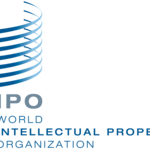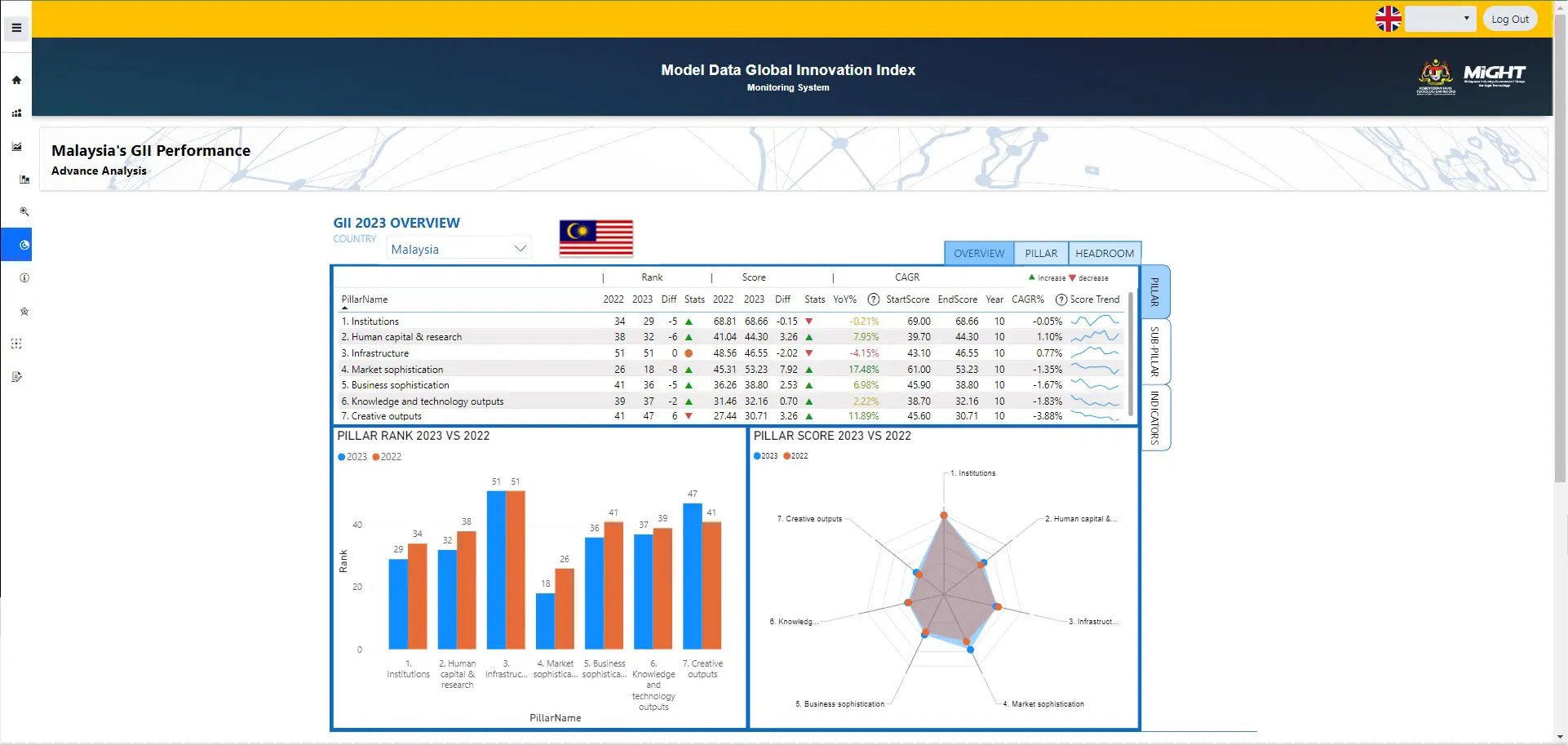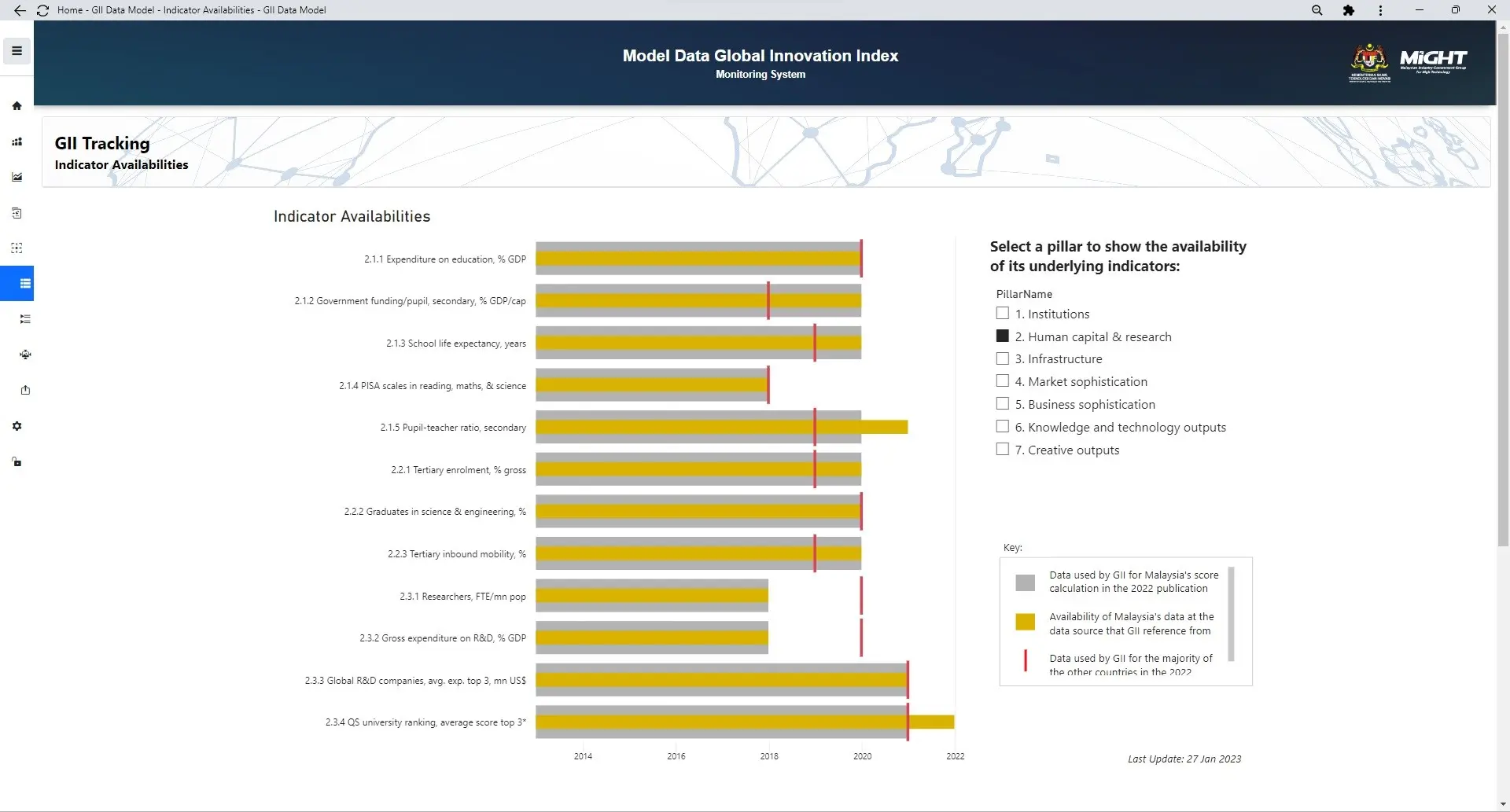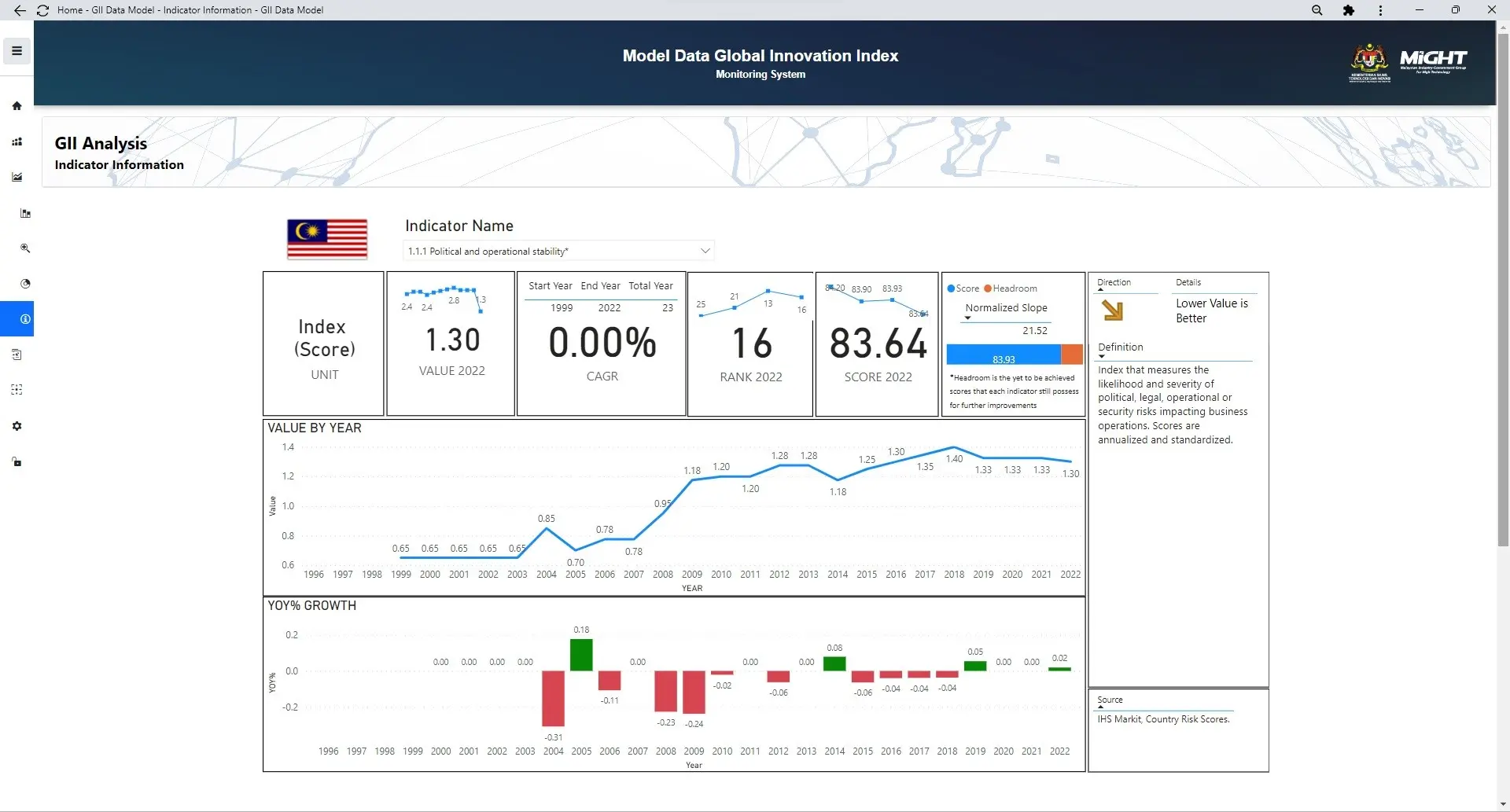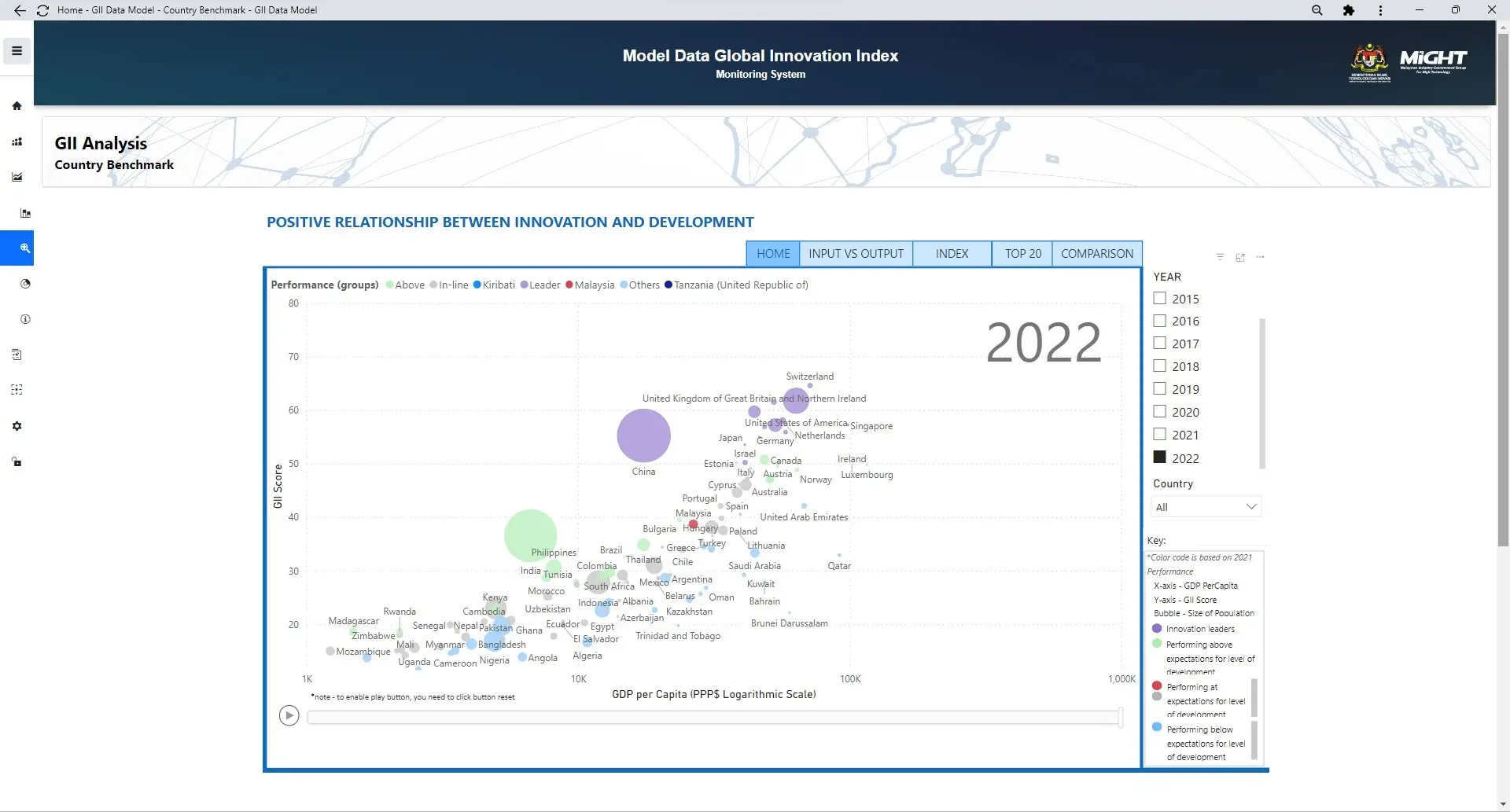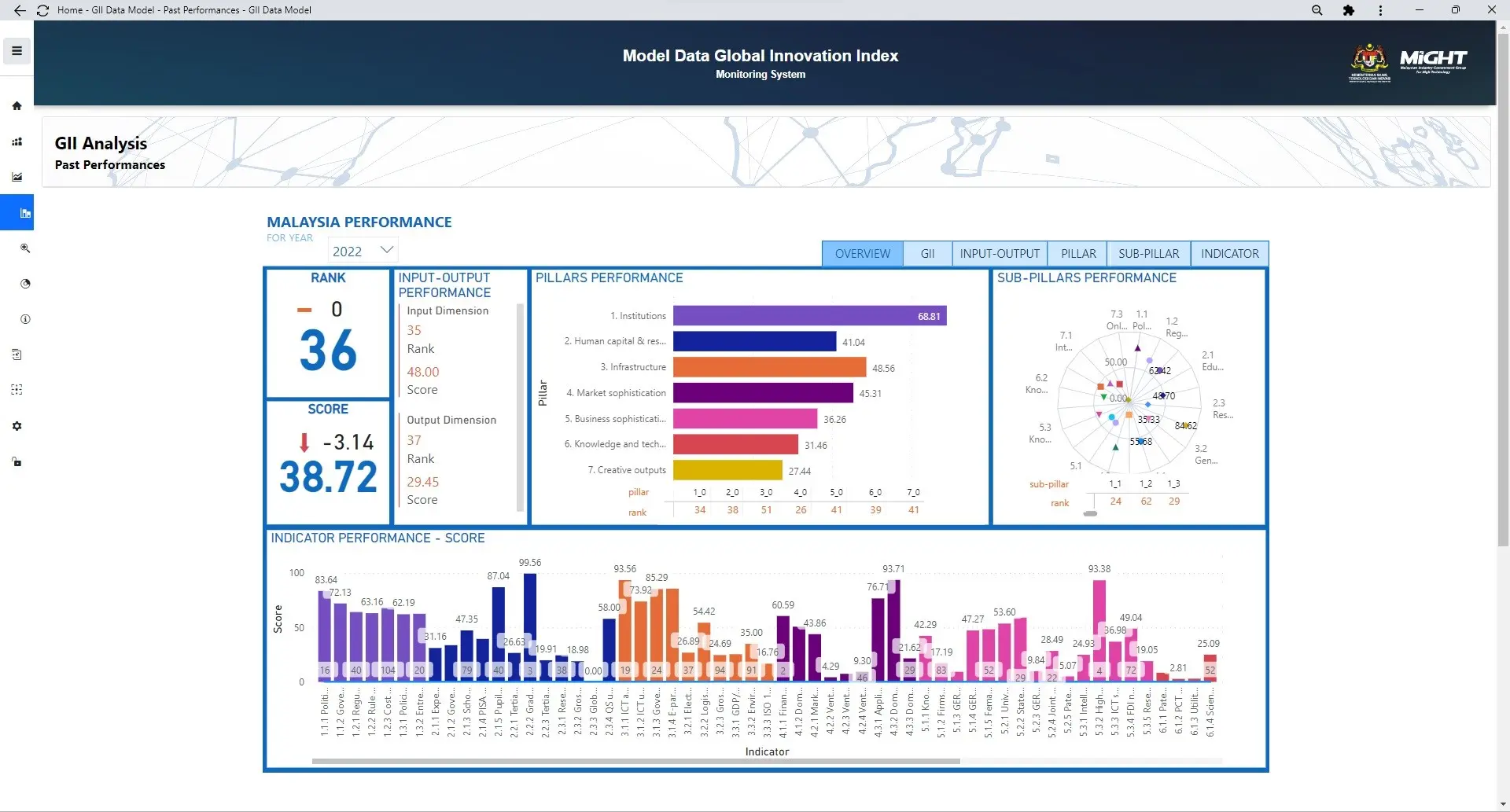Indeks Inovasi Global: Bab Malaysia
Pengumuman!



“ COUNTDOWN ”
- 0Days
- 0Hours
- 0Minutes
- 0Second
" The Twelfth Malaysia Plan (RMK-12) has set the target for Malaysia to rank 20th in the Global Innovation Index by 2025 "
Intro to Webpage GII
Webpage Global Innovation Index (GII): The Malaysia Chapter is now live!
Hello! GII's.
Welcome to the Webpage Global Innovation Index : The Malaysia Chapter , your one-stop destination for insights into the world of innovation! We are excited to present a comprehensive platform that sheds light on the transformative power of innovation across the globe.
The Global Innovation Index, or GII is a pioneering initiative brought to you by a collaborative effort between the World Intellectual Property Organization (WIPO), Cornell University, and INSEAD. This index serves as a crucial benchmark, evaluating and ranking the innovative capabilities of nations worldwide, especially Malaysia.
At our Webpage, we have assembled a wealth of information, data, and analyses about Malaysia's and the world's current status to help you understand the multifaceted dimensions of innovation. Explore the latest rankings of countries, delve into annual reports, and gain valuable insights into global innovation trends and best practices.
Our Webpage delves into a multitude of factors that contribute to innovation, ranging from research and development to investments in education, infrastructure, and technology. We also assess entrepreneurial activities and the protection of intellectual property, among many other essential aspects.
By providing this comprehensive overview, we aim to offer a clear perspective on how innovation can drive our nation (Malaysia) to positive change in various economic and social sectors. Nations that excel in the GII rankings are known for fostering innovation-friendly environments, leading to the development of cutting-edge technologies and solutions that impact society and economies in profound ways.
Policymakers, business leaders, researchers, and curious minds can all benefit from our Webpage's extensive data. Through GII, we hope Malaysians to foster a better understanding of the pivotal role innovation plays in shaping the trajectory of countries and offer valuable insights to enhance the quality of life and global competitiveness.
News & Events Calendar
KEEP UPDATE ON GII MALAYSIA
UPCOMING NEWS & EVENTS
Start Date:
26 Sep 2024 @ 07:30pm
End Date:
- 26 Sep 2024 @ 09:30pm
Location/Platform :
Chem. des Colombettes 34, 1202 Genève, Switzerland
2 months to go
for-css
hence
2 months to go
Date@Time: 26 Sep 2024 @ 07:30pm - 26 Sep 2024 @ 09:30pm
Location/Platform :
Chem. des Colombettes 34, 1202 Genève, Switzerland
Source : www.wipo.int
Source : https://mastic.mosti.gov.my
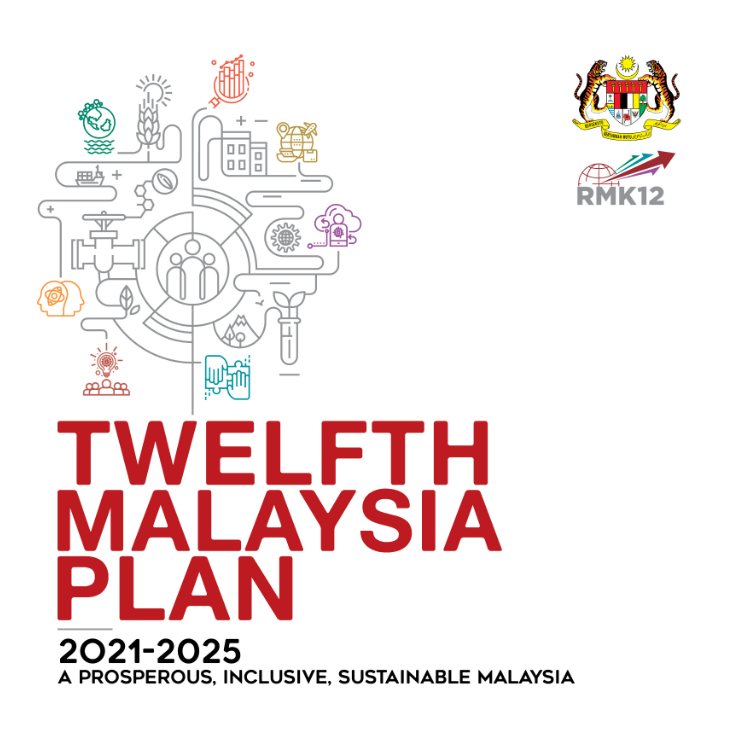
The 12MP or RMKe-12
The 12MP or RMKe-12
The Twelfth Malaysia Plan otherwise known as the 12th Malaysia Plan and abbreviated as "12MP" or (Malay: Rancangan Malaysia Kedua Belas - RMke-12), is a comprehensive blueprint prepared by the Economic Planning Unit (EPU) of the Prime Minister's Department (PMO) and the Ministry of Finance. You can find more information about the GII in 12MP here specifically in [p.342, p.348, p.387, p.388 & p.391].
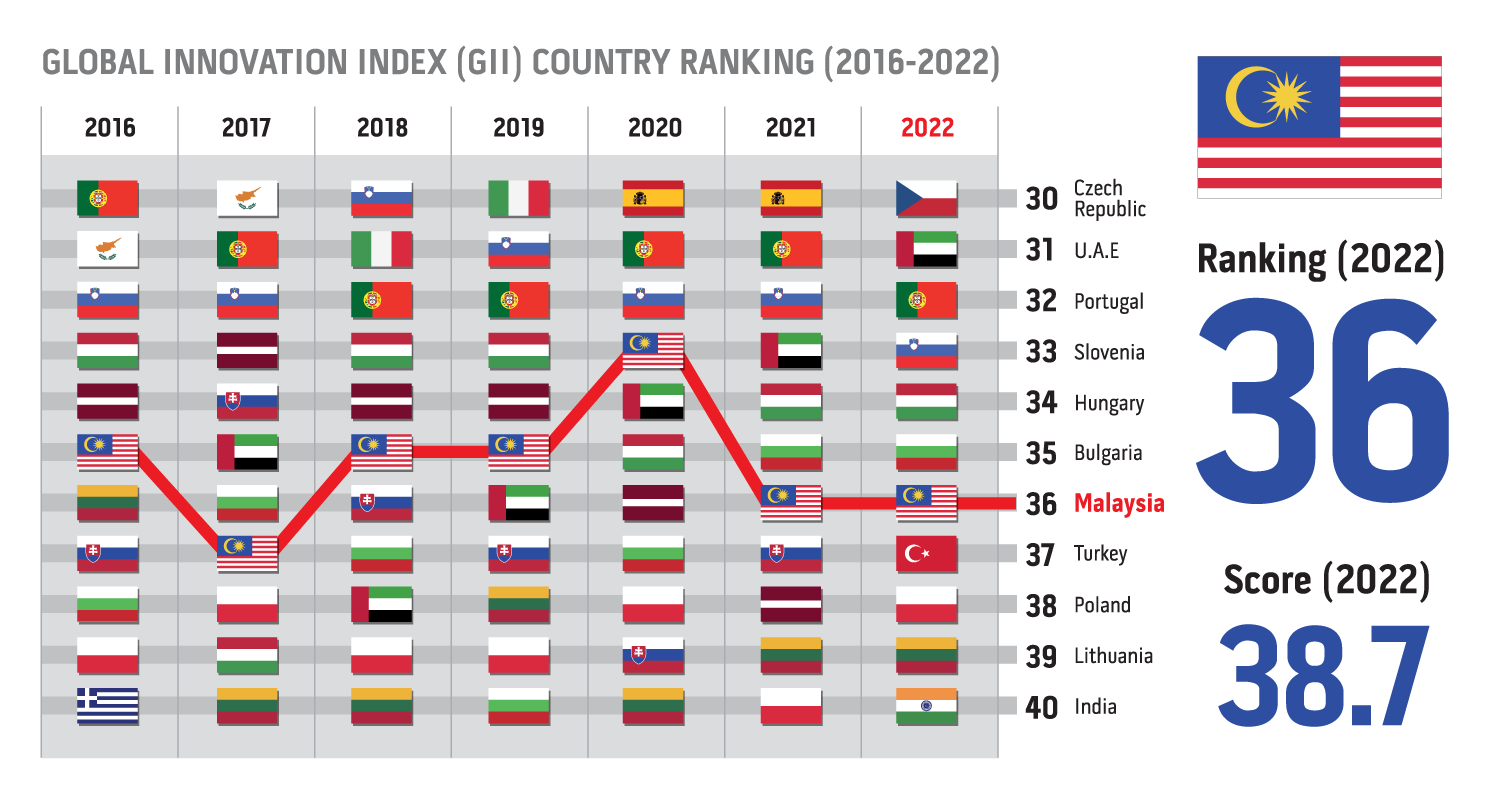
GII Monitoring System also known as "Model Data Global Innovation Index"
GII Monitoring System also known as "Model Data Global Innovation Index"
The Global Innovation Index (GII) monitoring system called as "Model Data Global Innovation Index" is a tool that was specifically developed to track Malaysia’s GII scores & ranking from the past year since 1996 to the next foresight year ahead. The system is managed by MASTIC-MOSTI and MIGHT (Strategic Partner) in the Jawatankuasa Inter-Agensi Pemantauan Daya Saing GII (JIPGII), which is a committee established by the Ministry of Science, Technology and Innovation (MOSTI). The purpose of the system is to monitor Malaysia’s past performance, country benchmarking, details of indicator information, simulation of data/scenarios that have the potential to predict and subsequently improve the country’s position, and tracking to track the year used for each indicator for Malaysia and to compare/monitor targets and actual data from time to time. You can find more information about the Portal called System Model Data GII HERE.
We invite you to embark on an exciting journey of discovery with the Webpage Global Innovation Index: Malaysia Chapter. Whether you're seeking to learn, analyze, or collaborate, we are here to empower your understanding of the world of innovation.
Top 10: The World’s Most Innovative Countries – Global Innovation Index 2022.
Switzerland, the U.S., Sweden, the United Kingdom and the Netherlands are the world’s most-innovative economies according to WIPO's Global Innovation Index 2022.
Source : www.wipo.int
Current Year GII Report
The 2022 Global Innovation Index
The main objective of the Global Innovation Index (GII) reports 2022 is to track the most recent global innovation trends against the background of an ongoing COVID-19 pandemic, slowing productivity growth and other evolving challenges. The GII reports 2022 aim to provide a comprehensive and multidimensional measure of innovation performance for 132 economies, highlighting their innovation strengths and weaknesses. The GII reports 2022 also focus on the future of innovation-driven growth, exploring whether stagnation and low productivity growth are here to stay, or whether we are about to enter a new era,
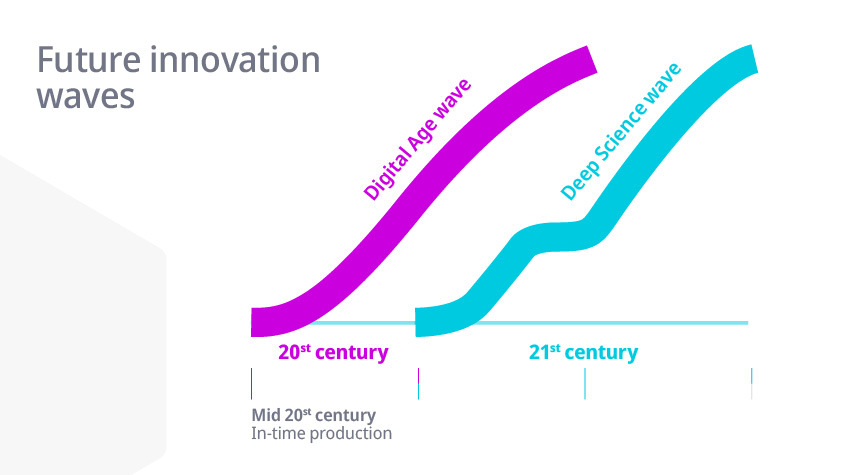 Source : www.wipo.int
Source : www.wipo.int
where new innovation spurts - the Digital Age and the Deep Science Innovation waves - bring about an economic uplift. The GII reports 2022 offer insights and recommendations for policymakers, business leaders, innovators and researchers on how to foster innovation and leverage its potential for sustainable and inclusive development.
Global Innovation Index 2022: What You Need to Know by WIPO
Source : www.wipo.int
An overview of the key findings of the Global Innovation Index (GII) 2022
Switzerland, the United States, Sweden, the United Kingdom and the Netherlands are the world’s most-innovative economies, the GII finds, with China on the threshold of the top 10. Other emerging economies are also showing consistently strong performance, including India and Türkiye, both of which enter the top 40 for the first time. Published on 29 September 2022, the GII 2022 ranks the innovation performance of 132 countries and economies around the world. Themed "What is the future of innovation-driven growth?", this year’s edition focuses on the effect of innovation on productivity and wellbeing of society over the coming decades.
#WIPO #GlobalInnovationIndex #GII2022 #Innovation

GII Conceptual Framework
Conceptual Framework for the Global Innovation Index 2022
The overall GII ranking is based on two sub-indices that are both equally important in presenting a complete picture of innovation; the Innovation Input Sub-Index and the Innovation Output Sub-Index.
Each of the five (5) input and two (2) output pillars is divided into three sub-pillars, each of which is composed of individual indicators – a total of 81 this year (see the Economy profiles section for the Framework of the Global Innovation Index 2022).
A detailed elaboration of the conceptual framework and pillars can be found in the 2020 edition of the GII. Each sub-pillar is calculated by taking the weighted average of its individual indicators’ scores, which are normalized to again produce scores between 0 and 100.
Pillar scores are calculated using the weighted average of each pillar’s sub-pillar scores.
Hence, three indices are calculated:
01
Innovation Input
Sub-Index
Five input pillars capture elements of the economy that enable and facilitate innovative activities.
02
Innovation Output
Sub-Index
Two Innovation outputs pillars are the result of innovative activities within the economy.
03
The overall
GII score
Is the average of the Input and Output Sub-Indices, on which the GII economy rankings are produced.
Definitions of the pillars and what they evaluate:
5
Input Pillar
Innovation Input
Sub-Index
The first sub-index of the GII, the Innovation Input Sub-Index, has five enabler pillars: Institutions, Human capital and research, Infrastructure, Market sophistication, and Business sophistication. Enabler pillars define aspects of the environment conducive to innovation within an economy.
- Pillar 1:Institutions
- Pillar 2:Human capital and research
- Pillar 3:Infrastructure
- Pillar 4:Market sophistication
- Pillar 5:Business sophistication
Institutions
It evaluates the quality and effectiveness of various institutions within a country's innovation ecosystem that play a crucial role in fostering and supporting innovation. It is designed to measure the enabling environment for innovation within a nation. Assessing the state of institutions within a country allows the GII to gauge the overall environment for innovation and identify areas where improvements or policy changes can enhance the innovation ecosystem and promote economic growth and development.
Sub-Pillars:
- Political environment
- Regulatory environment
- Business environment
Human capital and research
This pillar evaluates the availability and quality of human capital, as well as the research and development (R&D) activities within a nation. By evaluating the state of human capital and research within a country, the GII can provide insights into the country's capacity to innovate, the effectiveness of its educational systems, and the extent of its research and development activities. This information is essential for policymakers, businesses, and institutions in identifying strengths and weaknesses in the innovation ecosystem and formulating strategies to foster innovation and drive economic growth and competitiveness
Sub-Pillars:
- Education
- Tertiary education
- Research and development (R&D)
Infrastructure
This pillar evaluates the quality and effectiveness of infrastructure, both physical and digital, within a nation, as these factors play a critical role in supporting innovation and economic development. By assessing the state of infrastructure within a country, the GII provides valuable insights into its capacity to support innovation and create an enabling environment for businesses, entrepreneurs, and researchers to thrive. Strong and reliable infrastructure can enhance connectivity, facilitate knowledge sharing, attract investments, and ultimately contribute to a more innovative and competitive economy.
Sub-Pillars:
- Information and communication technologies (ICTs)
- General infrastructure
- Ecological sustainability
Market sophistication
This pillar evaluates the level of market sophistication and the effectiveness of market mechanisms in supporting innovation-driven activities and economic growth. By evaluating the level of market sophistication within a country, the GII provides insights into the country's readiness to adopt and absorb innovative technologies and solutions. A sophisticated market environment with skilled workers, supportive business conditions, and ample funding opportunities can stimulate innovation, attract investments, and foster a thriving ecosystem of innovation-driven enterprises.
Sub-Pillars:
- Credit
- Investment
- Trade, diversification, and market scale
Business sophistication
This pillar evaluates the sophistication of business activities and practices within a nation, with a focus on aspects that support innovation and entrepreneurship. By assessing the level of business sophistication within a country, the GII provides insights into the innovation readiness and capabilities of businesses. A sophisticated business environment that encourages R&D investments, fosters creativity, and supports entrepreneurship can stimulate innovation-driven growth, foster competitiveness, and contribute to the overall development of a knowledge-based economy.
Sub-Pillars:
- Knowledge workers
- Innovation linkages
- Knowledge absorption
2
Output Pillar
Innovation Output
Sub-Index
Innovation outputs are the results of innovative activities within the economy. Although the Output Sub-Index includes only two pillars, it has the same weight in calculating the overall GII scores as the Input Sub-Index. There are two output pillars: Knowledge and technology outputs and Creative outputs. Although the Output Sub-Index includes only two pillars, it has the same weight in calculating the overall GII scores as the Input Sub-Index.
Knowledge and technology outputs
This pillar evaluates the tangible outcomes of a country's innovation efforts and the knowledge-intensive activities that contribute to technological advancement and economic growth. By assessing the knowledge and technology outputs of a country, the GII provides insights into the impact and effectiveness of its innovation ecosystem. A strong performance in this pillar demonstrates a country's ability to generate new knowledge, technological solutions, and intellectual property, which are essential drivers of economic competitiveness and sustainable growth. Additionally, a country's capacity to contribute to the global knowledge pool and attract international recognition further enhances its status as an innovative and dynamic player in the global economy.
Sub-Pillars:
- Knowledge creation
- Knowledge impact
- Knowledge diffusion
Creative outputs
This pillar evaluates the creative aspects of a country's innovation ecosystem, focusing on the generation and utilization of creative products and outputs. By assessing the creative outputs of a country, the GII provides insights into its ability to foster and capitalize on creativity as a driver of innovation and economic development. A strong performance in this pillar indicates a vibrant creative sector, the capacity to produce and market cultural and creative products, and the potential to leverage creative assets for economic growth and cultural enrichment. Emphasizing creative outputs can contribute to the overall innovation ecosystem and enhance a country's competitiveness in the global creative economy.
Sub-Pillars:
- Intangible assets
- Creative goods and services
- Online creativity
Malaysian GII Overview
An Overview of the Global Innovation Index for Malaysia(2013-2022)
Here is a simplified an interactive GUI dashboard that shows an overview about Malaysia Global Innovation Index measured and ranked in 10 years based on GII reports between year 2013-2022. It typically covers various aspects related to innovation performance, including institutions, human capital and research, infrastructure, market sophistication, business sophistication, knowledge and technology outputs, and creative outputs published by the World Intellectual Property Organization (WIPO) and its partners, which is typically released in September each year. This report provides a detailed analysis of Malaysia's innovation performance, its strengths and weaknesses, and its ranking. It also highlights specific indicators and factors contributing to Malaysia's innovation ecosystem. To get the most accurate and up-to-date information, we recommend checking the official WIPO website for the Global Innovation Index report here.
Source : MIGHT Malaysia
Source : MASTIC Portal
Malaysian GII Analysis
GII Data Analysis
Advance Analysis is used to access detailed reports on the analysis of pillars, sub-pillars, and indicators, performance of indicators compared to the previous year, and headroom availability for… Read More
GII Indicator Data Availabilities
Module Tracking is a module for storing information regarding the availability years for each GII indicator of Malaysia and the years utilized by other countries. This module is intended to track… Read More
GII Indicator information
This module enables registered users to access detailed reports for each indicator, such as data trends, rankings, and scores for the latest year, normalized slope, available headroom, and also… Read More
GII Country Benchmark
This module is intended to display data through visualization, making it easier for users to understand the presented statistics/information. This model allows users to access reports on Malaysia'… Read More
GII Past Performances
Module Tracking is a module for storing information regarding the availability years for each GII indicator of Malaysia and the years utilized by other countries. This module is intended to track… Read More
For more info: Portal System Model Data GII
Infographic Malaysia Innovation Information




About JIPGII
The Inter-Agency GII Competitiveness Monitoring Committee (JIPGII)
Established in January 2021, the formation of this Committee is an initiative by the Ministry of Science, Technology, and Innovation (MOSTI), aligned with the Government's aspiration in the Twelfth Malaysia Plan (12MP) to position Malaysia among the top 20 countries in the Global Innovation Index (GII) by the year 2025. The establishment of this committee is also seen as capable of providing impact and added value to the nation's innovation ecosystem, further enhancing the country's innovation performance effectively and efficiently through integrated inter-agency cooperation involving various ministries, departments, agencies, and private entities.
Through this committee, collaborative ties with the GII report publisher, particularly WIPO, can be established through strategic cooperation with the Intellectual Property Corporation of Malaysia (MyIPO), which is a WIPO member state.
The objective of establishing JIPGII:
- To implement and enhance the monitoring of competitiveness indices in a more systematic and effective manner to improve the country's performance in the Global Innovation Index (GII) report;
- To ensure the accuracy and timely collection, storage, and updating of indicators by data custodians in the international database, thereby showcasing the actual achievements of the country; and
- To identify short-term, mid-term, and long-term targets to improve scores and elevate Malaysia's position in the GII report.
3 PHASE: REALISING MALAYSIA’S ASPIRATION IN GII
Implementation phase and current status
PHASE 1a: MAPPING MALAYSIA'S STATE OF INNOVATION (√ DONE)
Objective: Establishing Malaysia's innovation ecosystem with its source and contribution of data to ensure comprehensiveness, accuracy and timeliness.
 PHASE 1b: COMMUNICATION MALAYSIA'S STATE OF INNOVATION (√ DONE)
PHASE 1b: COMMUNICATION MALAYSIA'S STATE OF INNOVATION (√ DONE)
Objective:
- Coordinating the relay of data information required for GII indicators in a timely manner by National data custodians to the respective international databases and
- Informing National Stakeholders on Malaysia's innovation strategies, initiatives and performance.
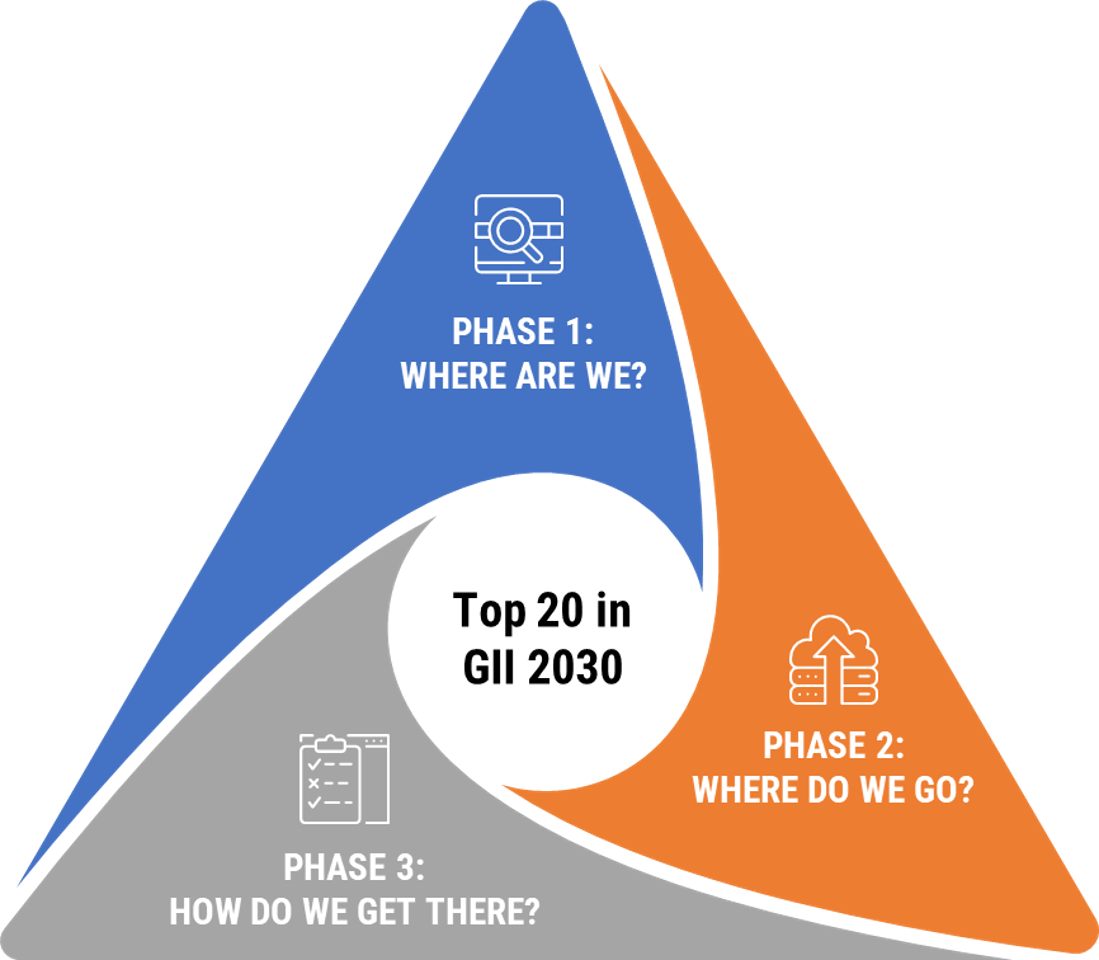
PHASE 2: ASPIRING FOR MALAYSIA'S STATE OF INNOVATION (√ DONE)
Objective:
- Benchmarking against global best practices of the GII and
- Setting the targets for Malaysia's aspiration in GII.
(Currently we are at this stage!)
PHASE 3a: MONITORING MALAYSIA'S STATE OF INNOVATION
Objective:
- Ensuring the strategies and initiatives are on track and recommending and
- Updating annual data of the GII indicators.
PHASE 3b: IMPROVING MALAYSIA'S STATE OF INNOVATION
Objective: Identifying short, mid and long-term strategies and implementing initiatives towards improving Malaysia's GII scores and ranking.
JIPGII Members
Pillar Lead: MRANTI
Ministries
- NRECC
- KKD
- MOT
- MOF
Agencies
- MCMC
- DOSM
- MAMPU
- MDEC
- JSM
- ST
Pillar Lead: MTDC
Ministries
- -
Agencies
- BNM
- BURSA MALAYSIA
- SECCOM
Pillar Lead: Cradle
Ministries
- MOHR
- MOHE
- MOF
- MITI
- MOSTI
- MASTIC
- Bhg. DANA
Agencies
- MIDA
- ASM
- MyIPO
- DOSM
- MPC
- BNM
- JPK
- MDEC
Pillar Lead: MyIPO
Ministries
- MOHE
- MITI
- MOF
- MOSTI
- Bhg. PTK
Agencies
- DOSM
- JSM
- MCMC
- PSM
- MRANTI
Pillar Lead: MIMOS
Ministries
- KKD
Agencies
- MATRADE
- MAMPU
- MyIPO
- MPC
- MYNIC
- DOSM
History
Sorry no records were found on the selected timeline.
Please change to another timeline...
GII FAQ
Frequently Asked Questions
The purpose of having a Frequently Asked Questions (FAQ) section here is to offer succinct and useful responses to commonly raised inquiries by users or customers regarding the Global Innovation Index (GII), the Inter-Agency GII Competitiveness Monitoring Committee (JIPGII), and MOSTI's initiatives in enhancing GII competitiveness performance.

Indeks ini mengukur ekosistem inovasi dalam ekonomi negara dan memberikan maklumat tentang kekuatan dan kelemahan negara dalam bidang inovasi. Sebilangan besar negara menggunakan GII untuk menilai dan menambah baik ekosistem inovasi mereka dan menggunakan GII sebagai rujukan dalam rancangan dan/atau dasar ekonomi.
a. Menganalisa prestasi ekosistem inovasi 132 negara.
b. Menyediakan kerangka kerja berdasarkan kepada tujuh teras bagi setiap negara untuk memperbaiki ekosistem inovasi masing-masing.
c. Menyediakan penandaaras berhubung polisi dan amalan terbaik dari perspektif inovasi untuk meningkatkan daya saing sesebuah negara di peringkat antarabangsa.
GII adalah laporan daya saing inovasi di peringkat antarabangsa yang diterbitkan oleh World Intellectual Property Organization (WIPO), Cornell University dan INSEAD. Laporan ini diterbitkan setiap tahun sejak tahun 2007.
Kerangka kerja GII terbahagi kepada dua (2) Sub-Index iaitu Innovation Input dan Innovation Output. Perincian adalah seperti yang berikut:
a) Innovation Input Sub-Index: Lima (5) Pillar iaitu Institutions, Human capital and research, Infrastructure, Market sophistication dan Business sophistication.
b) Innovation Output Sub-Index: Dua (2) Pillar iaitu Knowledge and technology outputs dan Creative outputs.
Terdapat tiga (3) jenis data yang diguna pakai dalam penilaian data GII iaitu:
a. Data kuantitatif/objektif/hard data: Merupakan data-data yang diperoleh daripada sumber awam dan swasta seperti UNESCO, WIPO, Thomsom Reuters dan lain-lain.;
b. Data komposit/indeks: Merupakan data-data komposit daripada agensi tertentu dan institusi akademik seperti World Bank, UN Public Administration Network (UNPAN), International Communication Union dan lain-lain.; dan
c. Data kualitatif/survei/soft data: Merupakan data-data yang diperoleh daripada soal selidik seperti Executive Opinion Survey yang dikendalikan World Economic Forum, Perbadanan Produktiviti Malaysia dan lain-lain.
Innovation Input Sub-Index merujuk kepada faktor-faktor yang mempengaruhi keupayaan negara untuk mencipta inovasi seperti sumber daya manusia, penelitian dan pembangunan, dan infrastruktur.
Innovation Output Sub-Index merujuk kepada hasil-hasil yang dihasilkan oleh negara dalam bidang inovasi seperti produk dan perkhidmatan, eksport teknologi tinggi paten dan sebagainya.
Bilangan indikator yang dinilai dalam GII adalah sebanyak 81 indikator untuk tahun 2022. Bilangan indikator mungkin sama atau berbeza bagi setiap tahun tertakluk kepada metodologi yang diguna pakai oleh WIPO bagi tahun berkenaan.
a. Kedudukan 20 ekonomi teratas pada tahun 2025 (RMKe-12).
b. Kedudukan 20 ekonomi teratas di bawah Pillar Knowledge and Technology pada tahun 2030 (MyDigital).
c. Skor 40-42 dalam Prestasi Petunjuk Prestasi Utama Ketua-Ketua Setiausa, Ketua-Ketua Pengarah, Setiausaha-Setiausaha Kerajaan Persekutuan dan Negeri.
Jumlah ekonomi/negara yang terlibat dalam penilaian mungkin sama atau berbeza pada setiap tahun. Pada tahun 2022, jumlah ekonomi yang terlibat adalah sebanyak 132 buah negara. Sesebuah negara hanya layak untuk dinilai sekiranya mempunyai liputan data sekurang-kurangnya 66% untuk Innovation Input Sub-Index dan 66% untuk Innovation Output Sub-Index.
Kedudukan GII sesebuah negara ditentukan dengan mengambil kira purata skor di antara Innovation Input Sub-Index dan Innovation Output Sub-Index. Ia menunjukkan sejauh mana input inovasi yang dilaksanakan mempengaruhi output inovasi bagi sesebuah negara.
Kaedah yang digunakan dalam pengukuran indeks GII adalah Purata Wajaran (Weighted Average). Pemberat yang digunapakai bagi pengiraan indeks GII adalah 0.5 dan 1.0 bergantung kepada jenis indikator. Untuk penerangan terperinci sila rujuk Nota Teknikal Laporan GII.
Definisi bagi setiap indikator boleh diperoleh daripada Appendix- Sources and Definition dalam Laporan GII.
Switzerland merupakan negara paling berinovatif di dunia bagi 12 tahun berturut-turut diikuti dengan negara Amerika Syarikat, Sweden, United Kingdom dan Belanda.
a) Prestasi sebenar negara terlibat;
b) Penyelarasan rangka kerja GII;
c) Pengemaskinian data, treatment of outlier serta missing data; dan
d) Negara yang terlibat dalam penilaian.
Malaysia tidak menyumbang data secara terus kepada WIPO. Data yang digunakan oleh WIPO hanya diambil daripada pelbagai sumber organisasi antarabangsa (seperti laporan dan pangkalan data).
a) Memberikan gambaran komprehensif berhubung ekosistem inovasi sesebuah negara.
b) Sumber maklumat berhubung amalan terbaik, penandaaras insiatif yang telah dilaksanakan oleh negara peneraju inovasi dan trend inovasi terkini di peringkat antarabangsa.
c) Sumber maklumat kepada syarikat-syarikat antarabangsa dalam proses mengenal pasti negara yang bersesuaian untuk mereka membuat pelaburan jangka masa panjang.
Malaysia telah menjadikan GII sebagai penanda aras bagi pengukuran inovasi negara. Malaysia telah tersenarai dalam penilaian Laporan GII sejak tahun 2007.
Tahap kecekapan negara sekiranya diukur daripada kualiti inovasi adalah setanding dengan negara ekonomi berpendapatan tinggi. Walau bagaimanapun, ia adalah rendah disebabkan oleh penghasilan output inovasi yang lebih rendah berbanding tahap pelaburan inovasi (input).
Prestasi Malaysia dalam GII secara keseluruhannya berada dalam lingkungan 32 ke 37. Kedudukan terbaik negara adalah ke-32 pada tahun 2012, 2013 dan 2015 manakala kedudukan terendah adalah ke-37 pada tahun 2017. Walau bagaimanapun, skor keseluruhan mencatatkan penurunan daripada 45.9% pada tahun 2012 kepada 38.7 pada tahun 2022. Skor Malaysia telah meningkat semula kepada 40.9% pada tahun 2023.
Jawatankuasa ini dipengerusikan oleh Timbalan Ketua Setiausaha MOSTI dan terdiri daripada tujuh (7) Jawatankuasa Kumpulan Kerja (JKK) seperti berikut:
a). JKK Pillar Institutions;
b). JKK Pillar Human Capital & Research;
c). JKK Pillar Infrastructure;
d). JKK Pillar Market Sophistication;
e). JKK Pillar Business Sophistication;
f). JKK Pillar Knowledge & Technology Outputs; dan
g). JKK Pillar Creative Outputs.
Punca kuasa penubuhan Jawatankuasa ini adalah daripada Keputusan Mesyuarat Majlis Inovasi Negara yang memutuskan supaya sebuah Jawatankuasa yang diterajui oleh MOSTI ditubuhkan untuk memantau pelaksanaan inisiatif oleh Kementerian/Agensi bagi meningkatkan indikator di bawah bidang masing-masing.
Jawatankuasa ini akan bersidang sekurang-kurangnya dua (2) kali setahun iaitu pada Q2 (April-Jun) dan Q4 (Oktober-Disember).
Urus Setia bagi Jawatankuasa ini adalah Pusat Maklumat Sains dan Teknologi Malaysia (MASTIC) dan Malaysian Industry-Government Group for High Technology (MIGHT).
Keutamaan Pegawai yang sesuai untuk dicalonkan bagi mewakili Kementerian/Agensi dalam Jawatankuasa ini ialah Pegawai Gred 48 dan ke atas. Walau bagaimanapun, Pegawai kumpulan P&P daripada Gred 41/44 juga boleh dicalonkan jika bidang tugas melibatkan pengurusan dasar/polisit/KPI dan strategik Kementerian/Agensi tersebut.
Ya, sebarang pertukaran pegawai yang telah dilantik bagi mewakili Kementerian/Agensi perlu dimaklumkan kepada pihak MOSTI bagi tujuan rekod.
Terdapat tiga (3) fasa pelaksanaan bagi Jawatankuasa iaitu:
a) Fasa 1: Di mana Malaysia - Pemetaan dan komunikasi tahap inovasi negara untuk mengenal pasti ekosistem inovasi Malaysia berdasarkan sumber dan penyumbang data bagi memastikan data yang komprehensif, tepat dan terkini serta menyelaras penyampaian maklumat dan data yang diperlukan bagi indikator GII tepat pada masanya oleh penyumbang data nasional kepada pangkalan data antarabangsa;
b) Fasa 2: Di mana arah laluan Malaysia - Aspirasi tahap inovasi negara untuk penandaarasan amalan terbaik global dan menetapkan sasaran untuk aspirasi Malaysia dalam GII; dan
c) Fasa 3: Bagaimana untuk mencapai sasaran - Meningkatkan dan memantau tahap inovasi negara untuk mengenal pasti strategi jangka pendek, pertengahan dan jangka panjang dan melaksanakan inisiatif untuk meningkatkan skor dan kedudukan GII Malaysia serta memastikan strategi dan inisiatif berada di landasan yang betul dan mengesyorkan langkah-langkah pembetulan jika diperlukan.
Menurut satu kajian oleh OECD, beberapa tindakan penting yang perlu diambil untuk meningkatkan keupayaan inovasi sesebuah negara adalah dengan melaksanakan strategi pembangunan berasaskan inovasi dan intervensi kerjasama antara Kerajaan dan swasta bagi meningkatan kadar FDI negara secara berterusan dalam pembangunan sumber manusia dan kemahiran, sains, teknologi dan inovasi.
Tujuan penubuhan Jawatankuasa ini adalah untuk melaksana dan menambahbaik pemantauan ke atas indeks daya saing supaya lebih sistematik dan berkesan dalam meningkatkan prestasi negara dalam Laporan GII. Penubuhan Jawatankuasa ini juga merupakan inisiatif MOSTI selaras dengan hasrat Kerajaan dalam Rancangan Malaysia Kedua belas (RMKe12) untuk meletakkan Malaysia dalam kalangan 20 negara terbaik dalam Laporan GII menjelang tahun 2025.
JIPGII adalah sebuah Jawatankuasa yang ditubuhkan oleh MOSTI sejak bulan Januari tahun 2021.
Pembekal data untuk GII terdiri daripada Kementerian, Agensi, Jabatan, Syarikat atau Individu yang mengemukakan data kepada badan penarafan antarabangsa. Data-data yang dibekalkan adalah daripada jenis hard data.
Sumber data yang digunakan oleh pihak penerbit diakses melalui Appendix dalam Laporan GII.
Ya, kesemua Kementerian/Agensi/Jabatan terlibat dalam GII. Kementerian/Agensi/Jabatan yang mempunyai indikator dan menyalurkan data secara terus dengan GII terlibat secara langsung dengan GII.
Walau bagaimanapun, terdapat Kementerian/Agensi/Jabatan lain yang turut menyumbang secara tidak langsung contohnya seperti pelaksana polisi yang turut menyumbang kepada ekosistem ekonomi negara.
Pillar Lead yang dilantik bertanggungjawab untuk mengadakan sesi libat urus bersama-sama ahli di bawah. Selain itu, Bengkel Scenario Building GII telah diadakan yang diuruskan oleh MIGHT dan MOSTI mengikut Pillar seperti berikut:
i). Pillar Infrastructure: 28 September 2022
ii). Pillar Human Capital & Research: 18 Oktober 2022
iii). Pillar Creative Outputs: 26 Oktober 2022
iv). Pillar Market Sophistication: 27 Oktober 2022
v). Pillar Institutions: 1 November 2022
vi). Pillar Knowledge & Technology Outputs: 2 November 2022
vii). Pillar Business Sophistication: 10 November 2022
Sistem Model Data GII dibangunkan oleh MOSTI dengan kerjasama rakan strategiknya iaitu MIGHT. Sistem Model Data GII ini boleh diakses melalui pautan gii.mosti.gov.my Sistem Model Data ini dibangunkan bertujuan sebagai kaedah kuantitatif penanda aras (Benchmarking) bagi mengukur tahap pencapaian inovasi negara berbanding negara-negara di seluruh dunia. Selain itu, Sistem Model Data ini juga sesuai digunakan sebagai medium pemantauan dan sumber panduan dalam proses membuat keputusan berdasarkan fakta berkaitan dasar/polisi/perancangan inisiatif/projek dan program. Sistem Model Data ini mengandungi maklumat terperinci seperti dashboard dan simulasi skor dan kedududukan negara, deskripsi dan sumber data diperolehi berbanding dengan negara-negara lain dalam tempoh 10 tahun (2013-2022). Untuk maklumat lanjut berkaitan Sistem Model Data ini sila berhubung dengan Urus Setia JIPGII di Talian Telefon: 03-8885 8652.
MOSTI sedang melaksanakan inisiatif pengumpulan maklumat program atau projek yang berkaitan dengan semua 81 indikator yang diukur dalam GII bagi kesemua Kementerian/Agensi melalui surat Ketua Setiausaha Kementerian yang bertarikh 15 Jun 2023.
MOSTI menyalurkan data secara terus kepada MPC selaku Partner Institute kepada Laporan WCY bagi data-data berkaitan Kajian Penyelidikan dan Pembangunan (R&D) Kebangsaan. Data yang dilaporkan dalam Laporan WCY juga turut dilaporkan dalam GCR.
i). Prestasi negara yang semakin menurun terutamanya dari segi skor;
ii). Polisi berkaitan GII yang tidak mencukupi; dan
iii). Prestasi terkini berkaitan compound annual growth rate (CAGR) yang rendah iaitu sekitar 3.18% berbanding CAGR yang perlu dicapai untuk mencapai kedudukan 20 teratas iaitu 11.19%.
Sebanyak 12 indikator telah dikenal pasti mempunyai sasaran high-priority dalam polisi Kementerian/Agensi dan 14 indikator pula dikategorikan sebagai medium high-priority. Selain indikator tersebut adalah dalam kategori low-priority.
Inisiatif pengumpulan data ini bertujuan untuk mengenalpasti dan mengemaskini pemilik data berkaitan serta memantau prestasi setiap indikator dalam Laporan GII melalui inisiatif/ program yang telah dilaksanakan di bawah Kementerian, Jabatan dan Agensi masing-masing. Maklumat yang dikumpulkan ini akan dikunci masuk ke dalam Sistem Model Data GII bagi tujuan pemantauan.
Maklumat yang perlu dikongsikan dengan MOSTI adalah maklumat berkaitan inisiatif, program atau projek yang dilaksanakan oleh Kementerian/ Agensi yang menyumbang kepada peningkatan prestasi dalam GII. Maklumat yang dikongsikan ini perlulah berkaitan dengan indikator GII (inisiatif oleh Kementerian).
Tarikh akhir untuk mengemukakan maklumat/data kepada pihak MOSTI atau Badan Pengumpul Data Antarabangsa sebelum skor dan kedudukan GII sesebuah negara dianalisis oleh WIPO ialah bermula selepas pelancaran Laporan GII (Sekitar Bulan September) sehingga selewat-lewatnya pada Bulan Mac Tahun berikutnya.
Antara inisiatif, program atau projek yang boleh dipertimbangkan adalah yang berkaitan dengan KPI Kementerian dan turut menyumbang secara langsung atau tidak langsung dengan peningkatan prestasi negara dalam GII.
Sesetengah indikator juga bergantung kepada 'secondary macro indicator' contohnya GDP/unit tenaga yang digunakan. Indikator yang patut diberi penekanan adalah indikator utama (Contohnya: unit tenaga).
Maklumat inisiatif, program atau projek yang disenaraikan perlu mengambil kira skop, KPI, sasaran, outcome yang mempunyai impak kepada prestasi GII.
Maaf, tiada keputusan dijumpai.
Cadangan Carian:
- Semak ejaan anda.
- Cuba lebih banyak perkataan umum.
- Cuba koasa kata yang berbeza yang membawa maksud perkara yang sama.
- Hantarkan pertanyaan anda dan pihak kami akan membantu anda mencarinya.
Maklumat/data boleh disalurkan kepada pegawai MOSTI yang berikut:
1.Nama : Puan Noor Fairuz Binti Shamsudin
E-mel/No. Tel. : noorfairuz@mosti.gov.my / 03-8885 8110
2.Nama : Encik Rudy Bin Nurdin
E-mel/No. Tel. : rudy@mosti.gov.my / 03-8885 8652

GII Reports Compilation
Reports on the Global Innovation Index (2007 - 2022)
Welcome to the Collection of Global Innovation Index Reports!
Dear readers and innovators, It is with great pleasure and enthusiasm that we open the doors to the prestigious collection of Global Innovation Index Reports. The Global Innovation Index (GII) is an annual report that has been published since 2007 and provides a comprehensive framework and a set of indicators to measure innovation performance of countries and economies around the world according to their innovation capabilities and outcomes, identifies their strengths and weaknesses, provides policy recommendations and best practices to foster innovation.
The GII report covers a wide range of topics related to innovation, including:
- Innovation Rankings:
The GII ranks countries based on their overall innovation performance. It provides a comparative analysis of how nations are faring in terms of fostering innovation.
- Innovation Inputs:
The report assesses the inputs and enablers that contribute to a country's innovation capabilities, such as investments in education, R&D, infrastructure, and information and communication technology (ICT).
- Innovation Outputs:
The GII evaluates the tangible and measurable results of innovation efforts, such as patents, publications, creative products, and high-tech exports.
- Innovation Policy Analysis:
The report analyzes innovation policies and strategies implemented by countries to support and encourage innovation within their respective economies.
- Innovation Impact:
The GII examines the impact of innovation on economic growth, productivity, and other developmental outcomes.
You can find more information about the GII reports from 2007 until 2022 below.
Together, let us unleash the potential of innovation and forge a world that knows no bounds
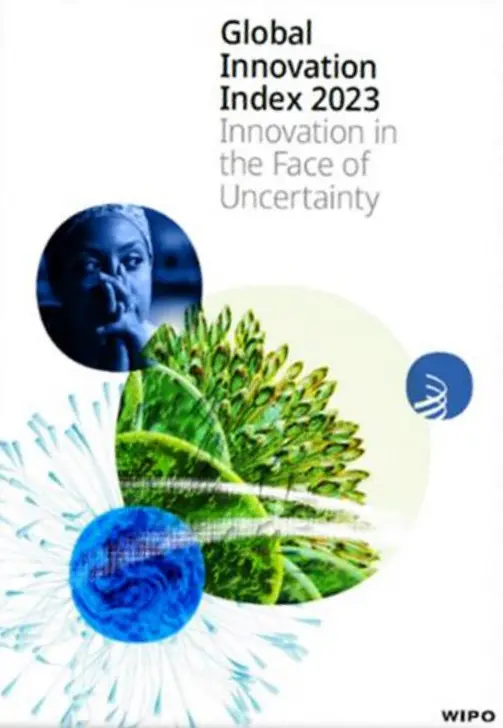
The Global Innovation Index 2023 (GII) takes the pulse of innovation against a background of an economic and geopolitical environment fraught with…
16thed.: 2023
New Ed. (Released on 27 Sept 2023)
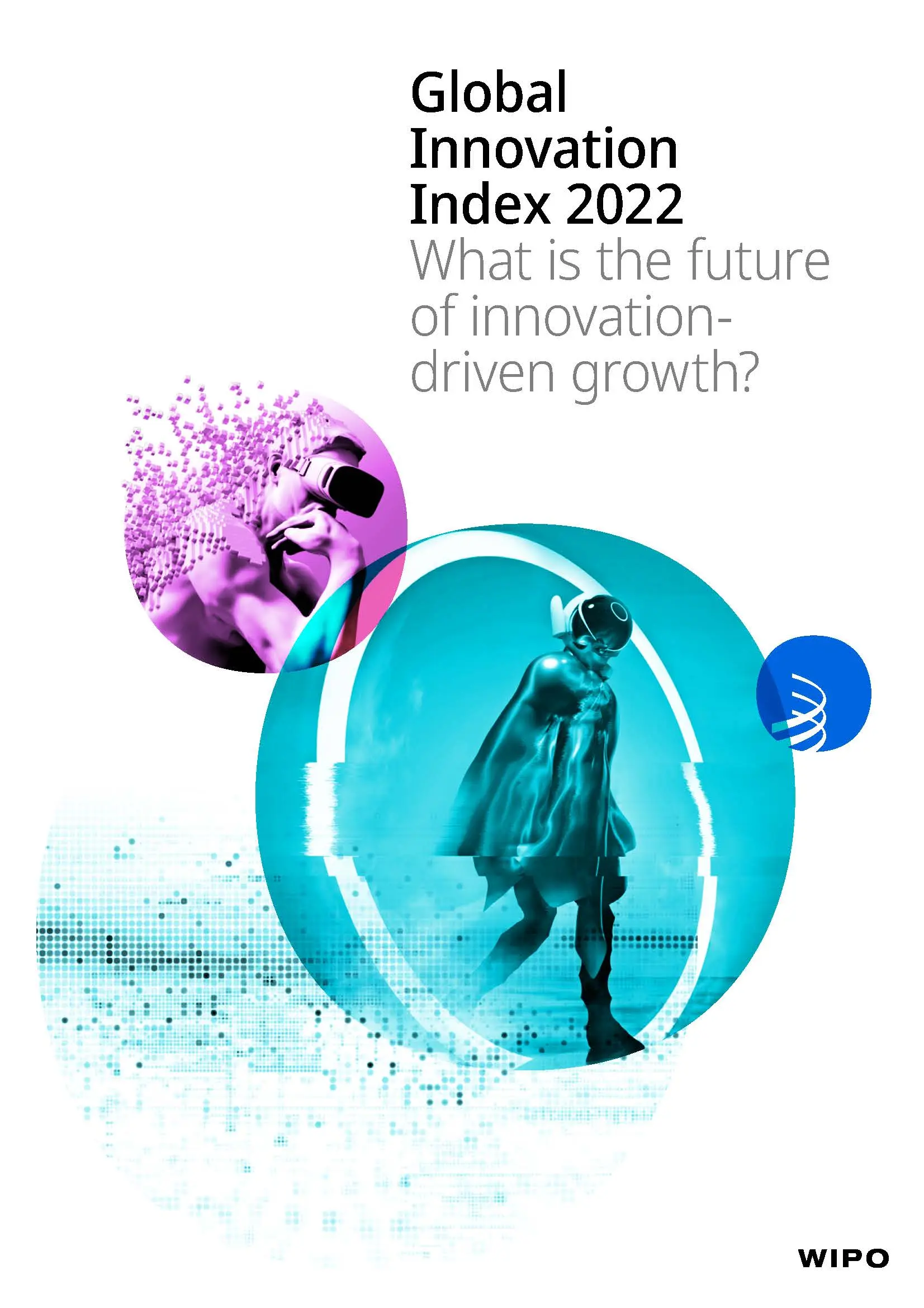
Global Innovation Index 2022 (GII) tracks global innovation trends against the background of an ongoing COVID-19 pandemic, slowing productivity…
15thed.: 2022
(Released on 27 Sept 2022)
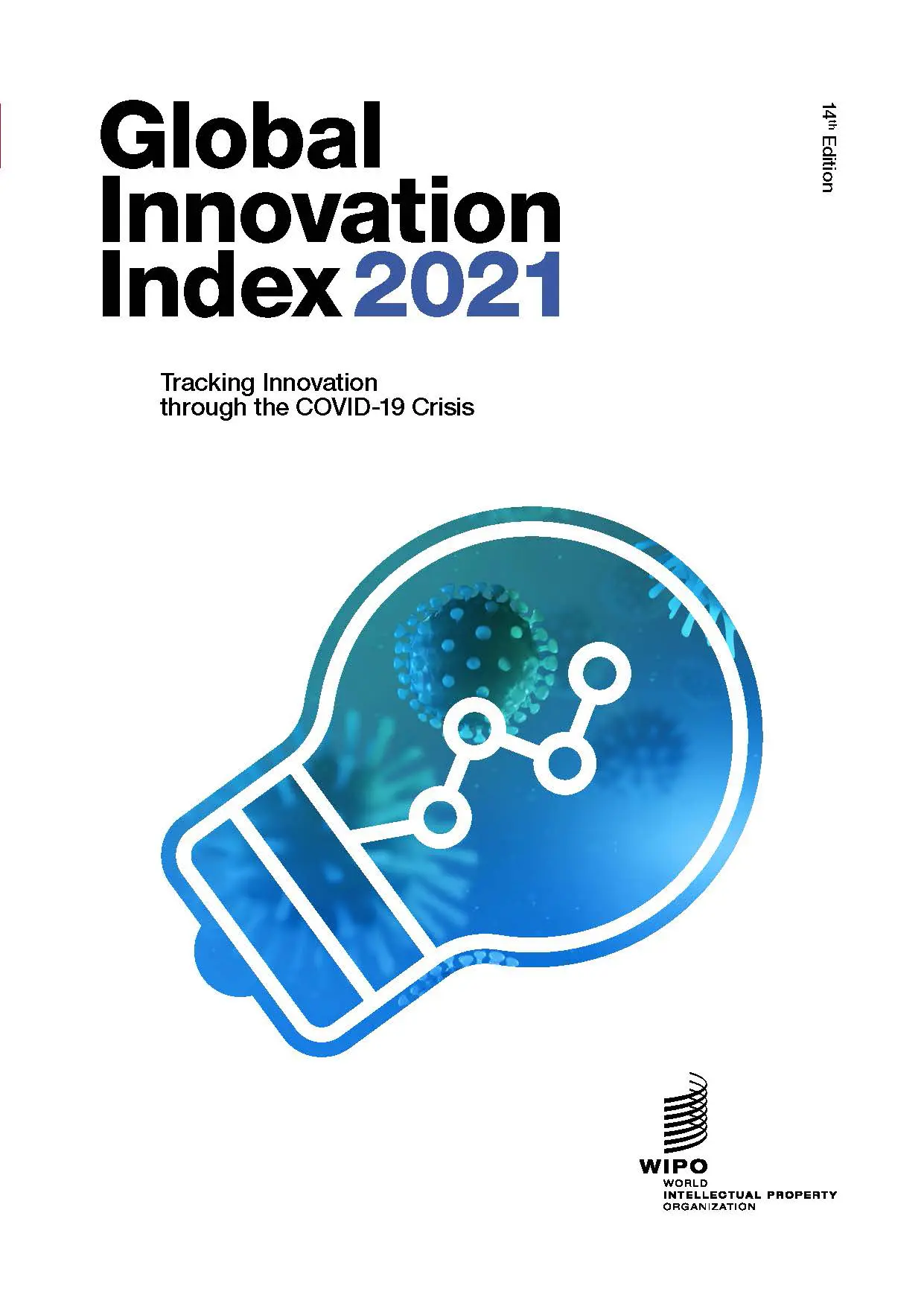
The Global Innovation Index 2021 takes the pulse of the most recent global innovation trends and ranks the innovation ecosystem performance of 132…
14th ed.: 2021
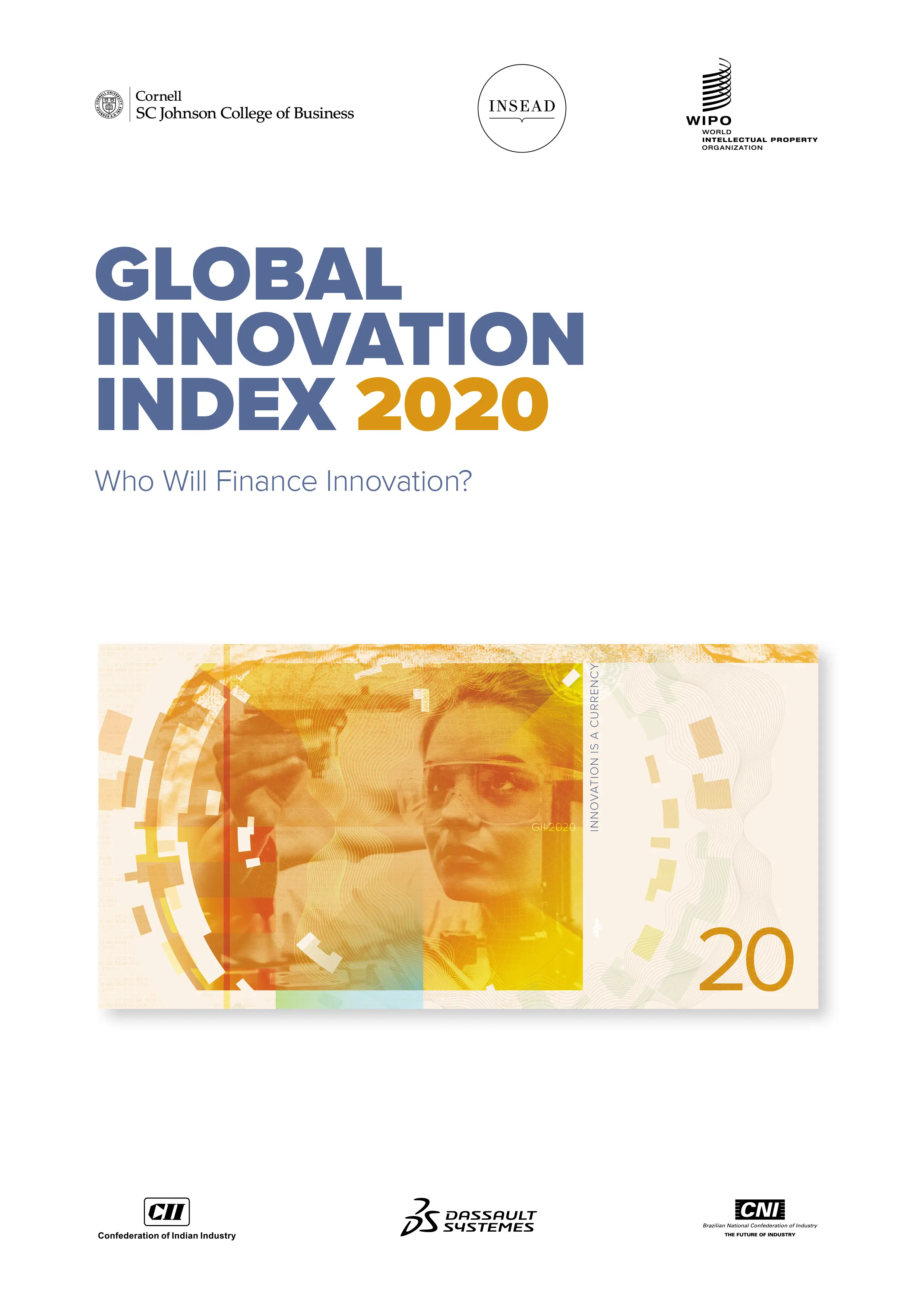
The Global Innovation Index 2020 provides detailed metrics about the innovation performance of 131 countries and economies around the world.
13th ed.: 2020
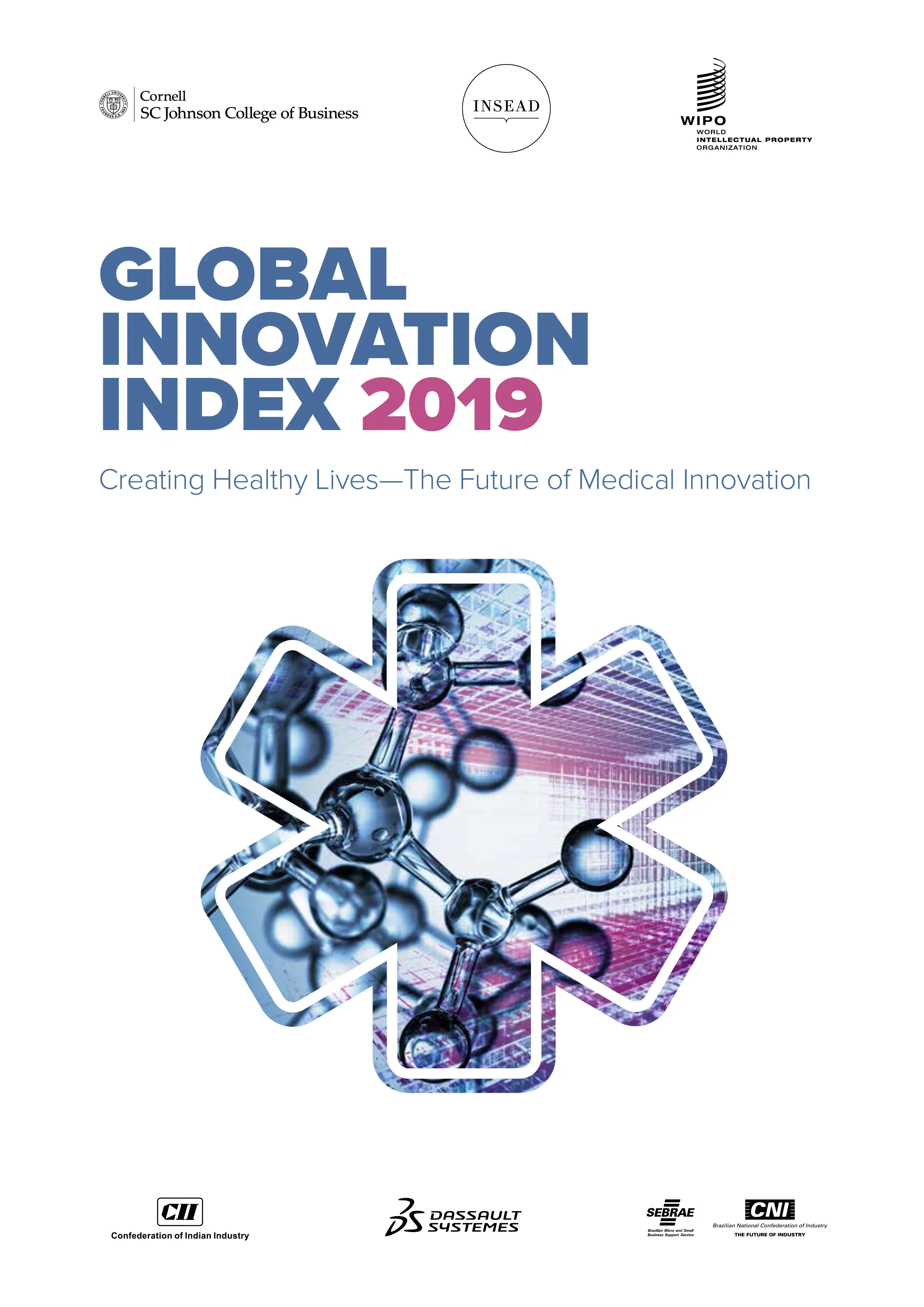
The Global Innovation Index 2019 provides detailed metrics about the innovation performance of 129 countries and economies around the world.
12th ed.: 2019
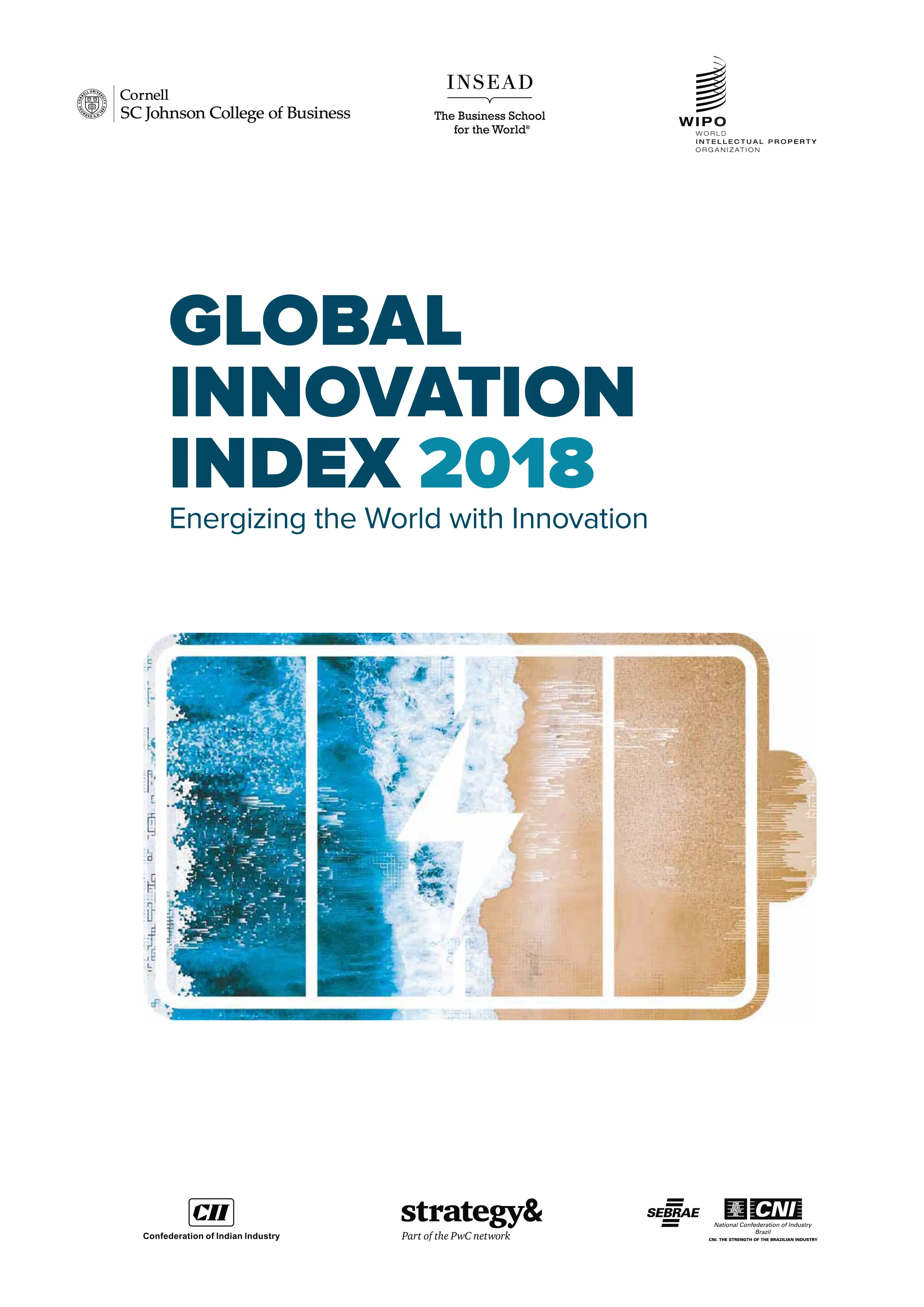
The Global Innovation Index 2018 provides detailed metrics about the innovation performance of 126 countries and economies around the world.
11th ed.: 2018
Contact Secretariat
GII Data Managment
Hi! Im MYGII

MII MASTIC

Administrator
Rudy Nurdin
03-8885 8652
rudy@mosti.gov.my

Administrator
Muhamad Baihaqi Ibrahim
03-8885 8110
baihaqi@mosti.gov.my
Help us with this survey
Please make your vote
Agency
Pillar Lead JIPGII
Pillar 1
Institution

Malaysia Productivity Corporation
Ilyana Norsaidah
Person In Charge
illyana@mpc.gov.my
03 - 7955 7266
Pillar 2
Human Capital & Research

Akademi Sains Malaysia
Teng Yu He
Person In Charge
teng@akademisains.gov.my
03 - 6203 0633
Pillar 3
Infrastructure

Malaysian Research Accelerator for Technology & Innovation
Nur Aliya Ayob
Person In Charge
aliya@mranti.my
03 - 8998 2020
Pillar 4
Market Sophistication
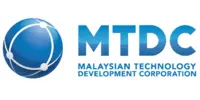
Malaysia Technology Development Corporation
Nor Halina Ghazali
Person In Charge
halina@mtdc.com.my
03 - 2172 6000
Pillar 5
Business Sophistication

Cradle Fund Sdn. Bhd.
Sitti Nursaadah Md Rusli
Person In Charge
sitti@cradle.com.my
03 - 4045 8600
Pillar 6
Knowledge & Technology Outputs
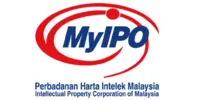
Intellectual Property Corporation of Malaysia
Meriam Nur Ahmad Hanbali
Person In Charge
meriam@myipo.gov.my
03 - 2299 8961
Pillar 7
Creative Outputs

Malaysian Institute of Microelectronic Systems
Siti Affida Zamry
Person In Charge
affida@mimos.my
03 - 8995 5000

